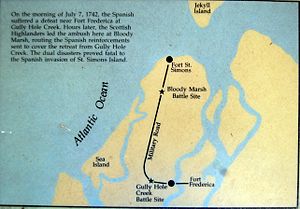Georgia Experiment facts for kids
The Georgia Experiment was a special rule in the early Georgia Colony. It made it illegal to own slaves. This rule was put in place by James Oglethorpe, who helped start Georgia, and other leaders called trustees. The British Parliament made it a formal law in 1735, just two years after Georgia was founded.
The ban on slavery lasted until 1751. By then, the threat from Spanish Florida had lessened. Also, rich landowners in Georgia, called the planter class, wanted to use slave labor. Because of these reasons, the British Parliament decided to end the ban.
Contents
Why Georgia Banned Slavery
Oglethorpe's Vision for Georgia
James Oglethorpe imagined Georgia as a fresh start for people who were in debt or had been in prison. He didn't want Georgia to become like South Carolina, where rich plantation owners used many slaves. Oglethorpe and the other trustees believed that everyone in Georgia should work hard and be independent. They thought that having slaves would stop people from working hard and would ruin their goal of helping people improve their lives.
Protecting the Colonies
The ban on slavery also had a military reason. In the 1700s, Spain controlled Spanish Florida, which was just south of Georgia. London (the British government) saw Georgia as a "buffer colony." This meant it was a protective zone to stop Spain from expanding north and to keep the richer British colonies safe.
Spain had a tactic of offering freedom to American slaves if they joined their military. So, having fewer slaves in Georgia made the colony safer from Spanish attacks. It also made it harder for Spain to get new soldiers.
How the Ban Was Put in Place
Oglethorpe and the trustees thought that Georgia would mostly grow crops like silk, which didn't need a lot of workers. They believed that white European families could do this farming on their own. They expected the early settlers to agree with their idea of a colony without slavery.
However, Oglethorpe didn't realize how much the colonists disliked hard farm work. They saw how much easier and richer their neighbors in South Carolina were, who used slave labor. Also, some plantation owners from South Carolina wanted to expand their farms into Georgia. They encouraged Georgians to ignore the ban on slavery.
Oglethorpe realized he couldn't keep the ban just by telling people to follow it. So, he asked the British Parliament for help. In 1735, the House of Commons passed a law that officially banned slavery in Georgia.
Fighting Against the Ban
The strongest opponents of the Georgia Experiment were a group called the Malcontents. Their leaders were Patrick Tailfer and Thomas Stephens. Unlike many early settlers who were helped financially by the trustees, most Malcontents were Scottish and paid for their own move to Georgia.
Stephens and Tailfer wrote many letters and articles against the ban. One important petition in 1738 had 121 signatures. When Oglethorpe and the trustees didn't change their minds, the Malcontents went to London to talk directly to the House of Commons. But Parliament didn't listen to their arguments as long as Spain was a military threat to the British colonies.
Quick facts for kids Battle of Bloody Marsh |
|||||||
|---|---|---|---|---|---|---|---|
| Part of the War of Jenkins' Ear & Invasion of Georgia |
|||||||
 A Map of the Bloody Marsh area as it was in 1742 (North is down) |
|||||||
|
|||||||
| Belligerents | |||||||
| Commanders and leaders | |||||||
| Strength | |||||||
| 650 soldiers, militia and native Indians | 150–200 soldiers | ||||||
| Casualties and losses | |||||||
| Light | 200 killed | ||||||
The Ban Ends
In 1742, Oglethorpe led the British to a big victory over the Spanish at the Battle of Bloody Marsh. This battle effectively stopped Spain from expanding further into North America. This great military win, however, also sealed the fate of his Georgia Experiment.
With the Spanish threat gone, the British Parliament had less reason to keep the unpopular ban on slavery. By 1750, the trustees agreed to Georgia's demands for slave labor. In that year, Parliament changed the 1735 law to allow slavery starting on January 1, 1751.
What Happened Next
After the Georgia Experiment ended, the colony quickly started using slaves, just like its neighbors. Ten years after the ban was lifted, Georgia had one slave for every two free people. By the start of the American Revolution, about half of Georgia's population were slaves.
With more slave labor, Georgia could produce more crops like rice and indigo. This helped the colony's economy grow a lot. Between 1751 and 1776, Georgia's population grew more than tenfold, reaching about 33,000 people, including 15,000 slaves.
However, not all white Georgians benefited. White workers who didn't have special skills and white craftspeople earned much less money because they had to compete with slave labor. This created a big gap between the rich plantation owners and the smaller farmers, independent craftspeople, and unskilled white workers. This division caused problems in the colony both before and during the Revolutionary War.

